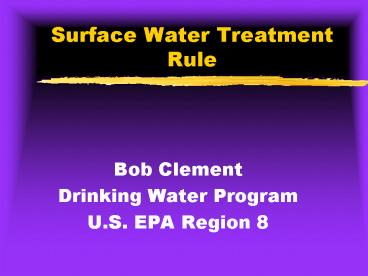Surface Water Treatment Rule - PowerPoint PPT Presentation
Title:
Surface Water Treatment Rule
Description:
Times New Roman Arial Black WP IconicSymbolsB Monotype Sorts Arial Contport.pot Microsoft Word Document Surface Water Treatment Rule Surface Water Treatment Rule ... – PowerPoint PPT presentation
Number of Views:127
Avg rating:3.0/5.0
Title: Surface Water Treatment Rule
1
Surface Water Treatment Rule
- Bob Clement
- Drinking Water Program
- U.S. EPA Region 8
2
Surface Water Treatment RuleGround Water
Reclassification
PWS TYPE STATE DETERMINATION BY
CWS 6/29/94 NCWS 6/29/99
40 CFR 142.16
(b)(2)(B) ________________________________________
_______________________________________
DETERMINATION ACTION Direct influence
Meet avoidance criteria within
of surface water 18 months or
Install filtration within 18
months 40 CFR 141.71
3
Surface Water Treatment RuleGeneral Requirements
- All surface water systems must
disinfect (40 CFR 141.70 (a)) - Minimum 99.9 / 99.99 removal or inactivation
of Giardia cysts / viruses
(40 CFR 141.70(a)(1 2)) - System operated by qualified personnel (40
CFR 141.70(c)) - Treatment specified by primary agency (source
water quality, site specific factors) (40
CFR141.70(a))
4
Surface Water Treatment RuleGeneral Requirements
- Applies to surface supplies and groundwater
supplies under the influence of surface water - Regulates for Giardia, viruses, Legionella,
heterotrophic bacteria, and turbidity
5
Cryptosporidium
Cryptosporidium can survive for months in soil
under cool, dark conditions and for up to a year
in low turbidity water. (Badenoch et al.,
1990) Cryptosporidium is ubitquitous. It is
found even in the most pristine watersheds.
6
Cryptosporidium
In almost all cases, wherever Giardia was
present, Cryptosporidium was also present.
(LeChevallier et al., 1991a) We simply did not
look for both at the same time in previous
studies. The highest level at a single site was
484 oocysts/L in Missouri.
7
Cryptosporidium
- It would take up to 29,000 mg/l of CL2 to
inactivate crypto. - Traditional chlorination doesnt work. Physical
removal by treatment is the only method of
reduction for crypto.
8
Cryptosporidium
In an immuno-compromised individual,
cryptosporidium can cause a debilitating
condition and may be fatal.
9
Surface Water Treatment Benefits
- 90,000 illnesses per year avoided
- Waterborne disease outbreaks avoided
- Improved consumer confidence, more aesthetic
water - Removal of precursors to disinfection
by-products - Removal of inorganic and synthetic organic
chemicals
10
Turbidity Monitoring RequirementsFiltered Systems
- One measurement every 4 hours of operation by
grab sample, or continuous monitoring - States may reduce monitoring to one grab sample
/ day in systems lt 501 people regardless of
treatment technology - Slow sand filtration and other technologies
- State may reduce monitoring to one grab sample /
day regardless of population size - (40 CFR 141.74(c)(1))
11
Turbidity Performance RequirementsFiltered
Systems
- All systems - never exceed 5 NTU (40 CFR 141.73)
- Conventional treatment, direct filtration lt
0.5 NTU 95 of measurements - (State may allow up to lt 1 NTU 95
of measurements) (40 CFR 141.73(a)) - Diatomaceous earth filtration - lt 1 NTU 95 of
measurements (40 CFR 141.73 (c))
12
Turbidity Performance RequirementsFiltered
Systems
- Slow sand and other filtration technologies
- lt 1 NTU 95 of measurements (State may allow up
to lt 5 NTU 95 of measurements but cannot
exceed 5 NTU) - (40 CFR 141.73 (b) and (d))
13
Turbidity Standards
- Systems using a technology other than
conventional, direct, slow sand or diatomaceous
earth filtration are in compliance if system
demonstrates to the State that alternative
filtration technology in combination with
disinfection (40 CFR 141.73(d))
14
Turbidity Standards
- alternative filtration technology in
combination with disinfection consistently
achieves removal and/or inactivation of - 99.9 of Giardia lamblia cysts (filtration
disinfection) - 99.99 of viruses (filtration disinfection)
- 99 of Cryptosporidium (filtration alone)
(Interim Enhanced SWTR 12/16/98)
15
Disinfection Requirements for Filtered Systems
- Entry point to distribution system 40 CFR
141.74(c)(2) - Distribution system 40 CFR 141.74(c)(3)
- Filtration and disinfection achieves at least
3/4 Log removal / inactivation (State
determination) 141.70 (a)(12)
16
Disinfection RequirementsEntry Point to
Distribution System
- Residual entering distribution system
- cannot be lt 0.2 mg/L for gt 4 hours
- gt 3300 people - continuous monitoring (grab
sample allowed every 4 hours up to 5 days if
monitoring equipment fails) 40 CFR 141.74(c)(2) - 1-4 samples / day allowed for systems serving lt
3301 people - If residual is lt 0.2 mg/L, must notify the State
before end of next business day
17
Disinfection RequirementsEntry Point to
Distribution System
- 1-4 samples / day allowed for systems serving lt
3301 people - SIZE OF SAMPLES
- lt 500 1
- 501-1000 2
- 1001-2500 3
- 2501-3,300 4
- If residual is lt 0.2 mg/L, must notify the State
before end of next business day - 40 CFR 141.74(c)(2)
18
Distribution System Disinfection Requirements
- Residual cannot be absent or HPC gt 500ml in gt 5
of samples/month for 2 mo. - Monitoring locations / frequency (same as total
coliform samples) - For systems receiving groundwater and surface
water, States may allow monitoring at surface
water sites 40 CFR 141.74(c)(3)(iii) - Above requirements do not apply if HPC monitoring
not feasible and State determines adequacy of
disinfection
19
Recommended Removal and Disinfection Levels
Assumed Log Recommended Log Removals Disinfe
ction Treatment Giardia Viruses _ Giardia
Viruses Conventional 2.5 2.0
0.5 2.0 Direct Filtration 2.0 1.0
1.0 3.0 Slow Sand 2.0 2.0
1.0 2.0 Filtration
20
Recommended Removal and Disinfection Levels
Assumed Log Recommended Log Removals Disinfe
ction Treatment Giardia Viruses _ Giardia
Viruses Diatomaceous 2.0 1.0
1.0 3.0 Earth Filtration Bag/Cart 2.0
0.0 1.0 4.0 Membranes As
determined by the State
21
Disinfection Contact Times
Contact time calculations will be easy when a
spreadsheet is published in the American Water
Works Associations OpFlow in the summer of 1999.

